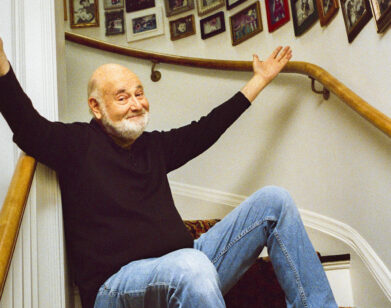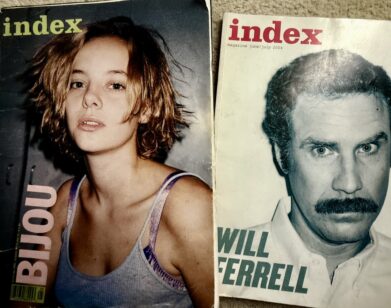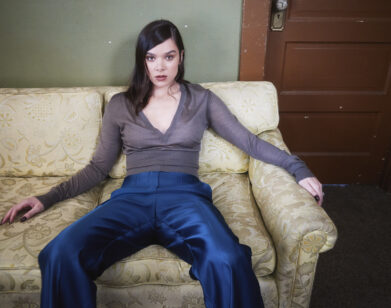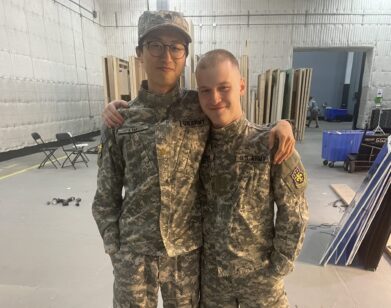Michael Mina Does Miami
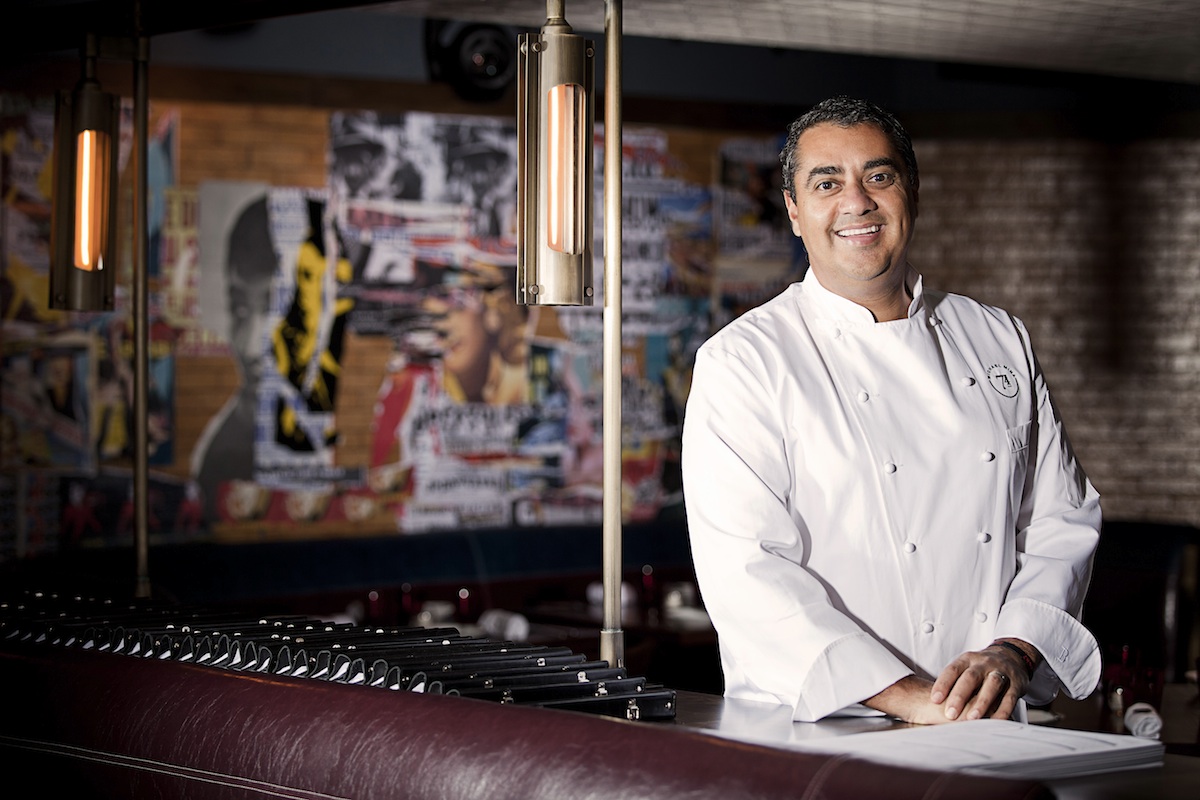
ABOVE: CHEF MICHAEL MINA AT MICHAEL MINA 74 IN MIAMI. PHOTO COURTESY OF BRANDON DEMONBREUN
When you walk into Michael Mina 74, which just opened at the expansive Fontainebleau resort in Miami, you may find yourself wanting to cancel the rest of your plans for the night. The space is warm, sleek, and utterly inviting, specifically designed to transition seamlessly from a restaurant into a lounge space—and equipped to, with heroically long food-service hours (through 3 a.m., on weekends!). Its cocktail menu, too, is extensive enough to keep you occupied for an entire night—or several—with options ranging from barrel-aged cocktails to punches on tap to carbonated, bottled drinks inspired by bar classics (we’re partial to the Kramer, a play on the Manhattan). The cocktails, like the food, are playful, but with an exquisite attention to detail: you might find your lime-twist garnish frozen right into the slender cylinder of ice in your drink, or discover the truffle doughnuts you’ve ordered arrive accompanied by a foie gras “frosting.” And it doesn’t get much more locavore than MM74’s seafood options: the resort’s private fishing vessel brings them back to the restaurant each morning.
Chef Michael Mina has had plenty of opportunity to fine-tune the art of opening a restaurant: MM74 is his 19th, opening two decades after Aqua, in San Francisco (now simply called Michael Mina), made him a culinary wunderkind at only 22 years old. He now has a presence in eight states. We got the chance to speak to Chef Mina during a very lively weekend in Miami (including a pretty fierce performance by Gloria Gaynor at the Fontainebleau’s legendary concert space, BleauLive), not long after Michael Mina 74 opened for business.
ALEXANDRIA SYMONDS: I would imagine that trying to decide what you’re going to do at some place with a history like the Fontainebleau’s is going to be very different from opening up a restaurant in Baltimore, or Jackson Hole. Do you feel like you have equal affection for all of those customer audiences or all of those customer bases? Does your heart still belong in California?
MICHAEL MINA: No! I love San Francisco, it’s very hard to compete with San Francisco when it comes to availability of product, but one thing you can’t replace about Las Vegas or Miami is people are walking in the door and they want to have a good time. They walk in, and this is the start of their good time. And this is such a fun element to have as a chef, and as a restaurateur, having a dining room full of people looking to have a good time. Your job is to exceed their expectations and get them off on the right foot to whatever they’re doing. I love that about Miami. I love the fact that for a lot of people, dinner’s not the end of the night. For some people it is, and that’s fine too. I think our restaurant has the quality level that it can handle both. It’s worth coming for just the dinner, but it’s the type of place that can really get you started for the evening.
SYMONDS: Were you always a food guy? Were you always in the kitchen as a kid?
MINA: I was. I liked to screw around in the kitchen when I was a kid. But I started cooking when I was 15. I played basketball, and I quit basketball in the middle of the season over a disagreement with my coach, and my dad got really upset with me. It wasn’t about basketball, it was just, “You don’t ever quit something you start, you quit at the end of the season, blah blah blah.” And I said no, I was a stubborn young kid. And he said, “Fine, start paying for your own things. Go get yourself a job.”
SYMONDS: Wow, he really threw you in the pool.
MINA: Yeah, so I went and got a job at a restaurant, and I was prepping and washing dishes. Just this little French restaurant in my town, very old-school: poached salmon, hollandaise, that type of thing. And I was just so intrigued by it, and the guy who owned it was the chef, and when I wasn’t working, I was helping. I would learn and learn and learn, and I just thought it was the coolest thing.
SYMONDS: Voluntarily?
MINA: Yeah, because the intensity level… I think I needed it, because I stopped playing basketball. I needed something intense in my life, and I just loved it and I loved being busy and all these things to do and from there, I started cooking every day. My last two years of high school I did work study half the day, and I ran the restaurant. It was just this little restaurant, but it was just so cool. I had 35, 40 employees.
SYMONDS: What was that like, to be a 17-year-old with a staff? I can’t even imagine.
MINA: It was cool, it was great. But it made me so much appreciate the whole experience. I loved the cooking, that was what I was passionate about, but getting to watch the guests eat—because you could see everything from the kitchen—just watching people eat and looking at the plates when they came back, just understanding, this is such an amazing job. And I was just getting out of high school and couldn’t think of anything I wanted to do more than cook, and here I am.
SYMONDS: When you were opening your first restaurant, what were some of the things you didn’t anticipate? What was the learning curve like for you?
MINA: When you’re young like that, you don’t understand how important design is, how much that affects guest experience. That was what I really learned with Aqua, and it was like the piece that I didn’t understand at all. I was just randomly interviewing designers, one thing I knew was that when you don’t know something, the best thing usually to do is ask everybody the same question. Just pick one question and ask until you find one you like.
SYMONDS: That’s the scientific method, yeah.
MINA: [laughs] Yeah. So I just asked every person, “If I select you to do this restaurant, what are you going to do to make this restaurant successful?” And everyone had a different answer, but this one woman said, “I’m going to make women look more beautiful in this restaurant than they do anywhere else.”
SYMONDS: [laughs]
MINA: And she went into every detail of how she was going to do it: the height of the ceilings, and the curvature, and the lights, and the color palette she’s going to use, and these big giant tilted mirrors. She was great. [laughs] But it so blew me away. I’m just sitting there like, “I can’t wait to hire you.” And that restaurant was so successful and I wholeheartedly feel a big part of it was because of that. People looked so good. The women looked beautiful, and then the men look good—that means the staff looks the best they’re going to look. And they’ll feel better. And she was so right.
SYMONDS: It just seems so logical, when you said it out loud. But you were quite young…
MINA: 22.
SYMONDS: What are some of the lessons you’ve learned in the interim years?
MINA: One thing about being a chef is everybody comes to you for everything, so you start answering every question. Pretty soon you’re fixing a toilet, and you think you’re a plumber; then you’re negotiating a lease, and you’re doing shit that you shouldn’t be doing, right? Early on, that’s what happens because you’re young and you have a lot of power, and people start coming to you for all the answers, and you feel like you need to have all the answers. What I’ve learned over the years is it’s so much better to surround yourself with real talent and hire real chefs. I learned more from the chefs I have working for me than you could ever imagine. There’s nothing wrong with being able to create opportunities for people, and you don’t have to do everything, take credit for everything, and have all the weight be on your shoulders. You really don’t, it really doesn’t make you better. But at the end of the day you do always have to be the person that’s relentless, that’s never satisfied. This is a crazy industry in the sense that there’s so much human nature in it that a restaurant, every day, is better or worse than it was before. So if you are satisfied, that just means you’re going this way, unfortunately. [laughs and gestures downward]
SYMONDS: Travel is very important to you, and there are a lot of eclectic world influences on Michael Mina 74’s menu. How much time in a typical year are you spending traveling and getting inspiration, versus being in your kitchens, and what are some of the experiences that informed this menu specifically?
MINA: I travel about 50 percent of my time. Every year I do something, big one-month trips. So this year I took my corporate chefs and my president, who runs all the front-of-house operations too, and we went all through Asia. We did Thailand, Singapore, Hong Kong, Japan, and the year before that we did Italy, Spain, all of that. And so I’d be lying to you if I didn’t tell you there’s a little more Asian influence on my menus now than before. [laughs]
SYMONDS: Any crazy stories from this last trip?
MINA: One night in Thailand, we were out in Chiang Mai, and they told us about this place that’s on the beach: “You’ve got to go, this lady will cook for you.” The cab driver drops us off and says, “You gotta walk way down there.” So we get out and start walking and we get chased by these two dogs, because there are a bunch of stray dogs. [laughs]
SYMONDS: And you’re just booking it down the hill?
MINA: We were running, but it was so funny because we get down there and there are the dogs at the house, right? And literally you’re out in their backyard, and there’s nobody else there, there’s us and a picnic table, and there’s no menu, and they just start cooking for you. And the dogs chase you down, but they’re not really chasing you, they’re actually…
SYMONDS: Guiding you? [laughs]
MINA: They’re your hostesses. Because then they hang out with you.
SYMONDS: Was it a good meal?
MINA: It was so good, it was unbelievable.
SYMONDS: What else played a role in developing the menu here?
MINA: My time in Miami. What I got to know, clearly, from being here is that people in Miami really like flavorful food. They like the bold flavors, and it works great because that’s how I cook to begin with.
SYMONDS: Yeah, so that must be so exciting for you.
MINA: Yeah, acid, sweet, spice, and fat. Those are the things you need to balance in your food, but when you start talking about bold food, those are the things you need to understand and work with. So I had a lot of fun with the menu, and the reason, there’s a reason why food in warm weather climates have acid in them, have spice in them, there’s a reason for it.
SYMONDS: Physiologically, you mean?
MINA: Yeah, it just kind of feels like what you want to eat when you’re there, and it’s funny because you go to Thailand or you go to these places with warm weather and you can really see that acid, sweet, spice, fat is really thought of; the dish is balanced like that. And then, I always like to do a few fun ones, a couple of plays on dishes. I did the jerk quail, with the foie gras and the mangos and the fava beans, that’s a really fun play on jerk chicken. I always like to do a few, we did a play on the caja china with the pig. And besides that, Miami is pretty global, so the idea of a menu that’s pretty global works well.
SYMONDS: It seems, also, from what I can tell, that there’s an emphasis on luxury ingredients. And Miami is certainly a luxury town.
MINA: Yeah, there’s some things I’m really, really happy about that we’ve done here that I’ve never done in any of my restaurants before. Here we have the Bleau boat, and that is just awesome. We get stone crab off of it every day, we get spiny lobsters off of it every day. So we’ve created these shellfish carts with shellfish from there, and the shellfish that I love from California from the Bay Area, and some other stuff from Maine.
I really love the sequence of service here. I’m really proud of the drink list and the cocktails, and as you’re browsing through the menu, the shellfish cart comes over, and then you can select anything you want. You can have one oyster, or you can do a tasting of all of it. They take your dinner order while you’re doing that, the shellfish person does the shellfish, and then you have this nice shellfish platter that fits your table right away. So it’s kind of constant stimulation, that’s kind of what it felt like, this modern-day supper club American bistro.
SYMONDS: Do you have any seminal eating experiences?
MINA: Yeah, I would say mine was probably Zuni Café in San Francisco, because I was dying to move to San Francisco, I wanted to live there. And when I went out there it was really right at the beginning of my culinary career and I didn’t really—I had heard about California cuisine and everything, and then everybody’s like, “Go to Zuni and have the roast chicken.” And I went there and it was just unbelievable, because it was something so simple, and you realized that the difference of the perfect product, the perfect cooking technique, the perfect bread salad, the perfect amount of acidity, with fat. That was the lightbulb for me, I was like, “That’s what cooking is all about.” That’s magic. It’s so simple, it’s a roast chicken, but my God.
MICHAEL MINA 74 IS OPEN NOW. FOR RESERVATIONS AND MORE INFORMATION, VISIT THE RESTAURANT’S WEBSITE.

